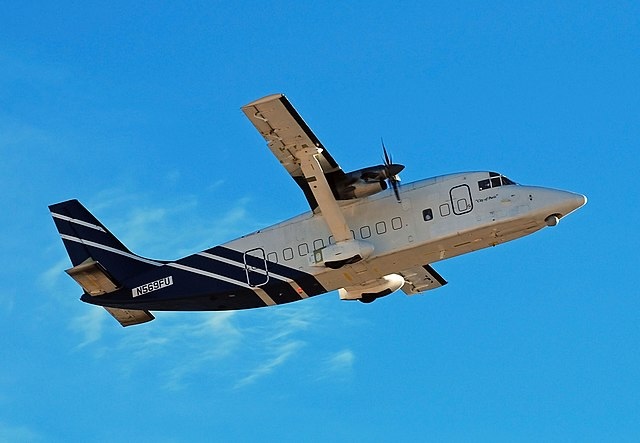Short 360
Summary
| Category | Military Transport Aircraft |
| Origin country | 🇬🇧 United Kingdom |
| Manufacturer | Short Brothers |
| First flight | 1 June 1981 |
| Year introduced | 1982 |
| Number produced | 165 units |
| Average unit price | $6.2 million |
Description
The Short 360 was developed by Short Brothers of Northern Ireland in response to the evolving commuter airline market of the 1970s, which sought aircraft with larger and more comfortable cabins than the prevalent 20-seat class. Building on their experience with the Skyvan and the Short 330, development of the Short 360 was announced in 1980. The prototype accomplished its first flight on 1 June 1981, followed by type certification on 3 September 1981. The first production aircraft undertook its maiden flight on 19 August 1982 and officially entered service with Suburban Airlines in November 1982. Subsequent developments included the 360 Advanced in late 1985, featuring more powerful PT6A-65-AR engines, and the 360/300 in March 1987, which incorporated PT6A-67R engines, six-blade propellers, and aerodynamic enhancements for improved cruise speed and performance. Production of the Short 360 concluded in 1991 after 165 units had been delivered.
The Short 360 is a derivative of the Short 330, designed to seat 36 passengers, or up to 39 in a high-density layout, while maintaining a high degree of commonality with its predecessor. Distinguishing features include a larger, swept tail unit mounted on a revised rear fuselage and a 3-foot fuselage plug that provided space for two additional seat rows and improved the aircraft's aerodynamic profile, thereby reducing drag. The cabin configuration typically featured two seats on the starboard side and one on the port side. Power was supplied by two Pratt & Whitney PT6A-65R turboprop engines, although later variants incorporated upgraded powerplants. The aircraft was unpressurized and utilized a NACA 63A modified airfoil. It was designed to operate from runways as short as 4,500 feet, with a cruise speed of approximately 215 knots at 10,000 feet. While not the fastest turboprop, it was recognized for its acceptable performance, reasonable cost, ease of maintenance, and quiet operation, being fully ICAO Stage 3 noise-compliant.
The aircraft was deployed in regional airline service worldwide and proved particularly popular with regional carriers in the United Kingdom, such as Manx Airlines, which utilized it for feeder services into larger hubs. By 1998, approximately 110 aircraft were in service, and by 2017, 42 units continued to operate with various civil operators, primarily in cargo roles. Military operators included the United States Army and the Venezuelan Air Force. Key operational strengths included its short-field capability, cost-effectiveness, serviceability, and low noise signature. A noted operational characteristic was that it was not the fastest aircraft in its market segment. The prototype, G-ROOM, was destroyed by an IRA bomb at Belfast City Airport in 1989.
Main Variants
- 360-100: The first production model, equipped with Pratt & Whitney Canada PT6A-65R turboprop engines.
- 360 Advanced: Introduced in late 1985 and later redesignated 360-200, this variant featured upgraded PT6A-65AR engines, each rated at 1,424 shp.
- 360-300: A development with more powerful PT6A-67R engines and six-blade propellers, offering higher cruise speed and improved operational performance.
- 360-300F: The dedicated freighter version of the 360-300, capable of carrying up to five LD3 cargo containers.
- Short C-23 Sherpa B+ and C: Military-configured Short 360s operated by the United States military, with the C-23B+ produced through conversions of civilian Short 360 airframes.
Technical specifications
| Version: 360-300 | |
|---|---|
| Crew | 3 |
| Operational range | 1,595 km (991 mi) |
| Maximum speed | 404 km/h (251 mph) |
| Wing area | 42.1 m² (453.1 sqft) |
| Wingspan | 22.8 m (74.8 ft) |
| Height | 7.2 m (23.7 ft) |
| Length | 21.6 m (70.8 ft) |
| Service ceiling | 6,100 m (20,013 ft) |
| Empty weight | 7,870 kg (17,350 lbs) |
| Max. takeoff weight | 12,292 kg (27,099 lbs) |
| Climb rate | 4.84 m/s (15.9 ft/s) |
| Powerplant | 2 x Pratt & Whitney Canada PT6A-65AR turboprop delivering 1062 kW each |
Current operating countries
| Country | Units | ||
|---|---|---|---|

|
Venezuela | 2 | |
All operators
